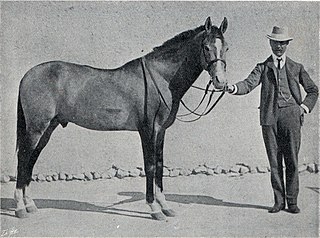
The Charolais or Charolaise is a French breed of taurine beef cattle. It originates in, and is named for, the Charolais area surrounding Charolles, in the Saône-et-Loire department, in the Bourgogne-Franche-Comté region of eastern France.

The Economic Cooperation Organization or ECO is an Asian political and economic intergovernmental organization that was founded in 1985 in Tehran by the leaders of Iran, Pakistan, and Turkey. It provides a platform to discuss ways to improve development and promote trade and investment opportunities. The ECO is an ad hoc organisation under the United Nations Charter. The objective is to establish a single market for goods and services, much like the European Union. After the dissolution of the Soviet Union, the ECO expanded to include Afghanistan, Azerbaijan, Kazakhstan, Kyrgyzstan, Tajikistan, Turkmenistan, and Uzbekistan in 1992.
The Qatgani or Qataghani is a horse breed from the former Qataghan province of Afghanistan. It is one of twelve Afghan horse breeds reported to the DAD-IS database of livestock breeds.
Agriculture in Central Asia provides a brief regional overview of agriculture in the five contiguous states of former Soviet Central Asia – Kazakhstan, Kyrgyzstan, Tajikistan, Turkmenistan, and Uzbekistan. Two other countries that are sometimes classified as Central Asian – Afghanistan and Mongolia – are included in this overview because of their substantially different background.

The Yonaguni or Yonaguni uma (与那国馬) is a critically-endangered Japanese breed of small horse. It is native to Yonaguni Island, in the Yaeyama Islands in south-western Japan, close to Taiwan. It is one of eight horse breeds native to Japan.

The Dosanko (道産子), also known as the Hokkaido Horse and Hokkaido Pony, is one of the eight extant indigenous horse breeds of Japan, and the only one of the eight not critically endangered. It originated on the island of Hokkaido, in the far north of the country, and is found particularly along the Pacific (eastern) coast of the island. The people of Hokkaido may be nicknamed "Dosanko" after the horses.

The Latvian Horse is a purpose-bred warmblood horse breed from Latvia. Breeding began in Latvia in the early twentieth century, and a herd book was established in 1927. The breed was officially recognised in 1952. There are two types, sometimes called the Latvian Harness Horse and the Latvian Riding Horse. The harness type was predominant until about 1960, when demand for sport horses increased and more of the saddle type were bred.

The Novokirghiz or New Kirghiz is a modern Kyrgyz breed of horse. It was developed in the Kirghiz Soviet Socialist Republic in the mid-twentieth century through cross-breeding of the traditional Kyrgyz Horse of the region with introduced horses of Thoroughbred, Don and Anglo-Don stock.

The Iomud is a breed of light horse from Turkmenistan. Like other breeds of Turkmen horse, it is named for the Turkmen tribe that raised it, the Iomud. Both the name of the horse and the name of the Turkmen clan may be spelt in many ways, including Iomud, Yomud, Yamud and Yomut. The Iomud horse is raised in Turkmenistan, particularly in the velayat of Daşoguz; in Uzbekistan; in Karakalpakstan, particularly in the Khwarezm region; and in Iraq, Iran and Turkey. Unlike the Akhal-Teke, it usually kept in herds in desert or semi-desert areas.

The Karabair is a long-established horse breed from Central Asia, and particularly from Uzbekistan and northern Tajikistan. It results from the cross-breeding of desert horses of Arabian or Turkmene type from the south with steppe horses from the north. It is a small, agile and versatile horse that can be used for riding or driving. It is well suited to local horse sports, and especially to the Uzbek national game, kokpar. It is also used for meat and milk production; the milk may be made into kumis.

The Lithuanian White is a Lithuanian breed of general-purpose pig. It was developed in the twentieth century in the Lithuanian Soviet Socialist Republic under the Lithuanian Animal Husbandry Research Institute of Baisogala, and was officially recognised in 1967. It derives from cross-breeding of local pigs with imported breeds including the Large White, the Deutsches Edelschwein and the German Landrace. It was bred for suitability to conditions in Lithuania, but spread to other parts of the Soviet Union including those that are now Belarus, Georgia, Kazakhstan, Turkmenistan and Moldova, and was also reared in parts of the Russian Republic.
The Azerbaijan, is an Azerbaijani breed or group of breeds of riding horse of Oriental type. In 2007 it was listed by the FAO as endangered; in 2021 it was not among the horse breeds reported to DAD-IS.

The Dongola or Dongolawi is an African breed of riding horse. It is predominantly of Barb type, though there may have been some Arab influence in the past. It originated in the Dongola province of Sudan, for which it is named. In eastern Africa it is distributed in the northern part of Sudan and in western Eritrea; it is also present in several West African countries including Cameroon, Chad and the Central African Republic. A number of local West African breeds or types derive from it; they may be regarded as sub-types, or may be reported as separate breeds.

The Swedish Red-and-White, Swedish: Svensk Röd och Vit Boskap, frequently abbreviated to SRB, is a Swedish breed of dairy cattle. It was created in the 1920s by crossing the Swedish Red Pied and Swedish Ayrshire breeds.
The Burmese Horse or Bama Myinn is a breed of horse from Myanmar (Burma). It is one of two horse breeds in Myanmar, the other being the Shan Horse.

The Kyrgyz Horse or Kirgiz Horse is a traditional breed of small horse from the Kyrgyz Republic (Kyrgyzstan). Kyrgyz people associate it with their nomadic past. During the Soviet era of Kyrgyz history, the Kyrgyz Horse was cross-bred with imported foreign breeds, including Don and Thoroughbred strains, to create a new and larger breed, the Novokirgiz or New Kirgiz.















